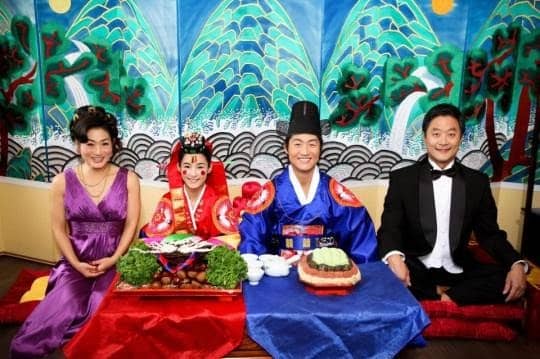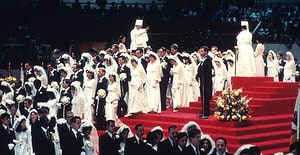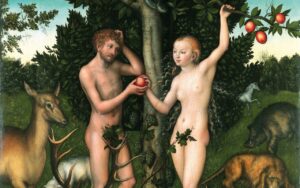This article argues that some societies do not have much of a romantic tradition and that in those societies, marriage is largely understood as a social transaction. Passionate, romantic, or amorous love between a man and a woman can be less socially acceptable than common sexual desire.

In this article, we will explore some of the romantic traditions that exist in various countries around the world, note how marriage can be seen other than as a social transaction, and contrast romantic love with sexual desire.
Yet, there is a difference between the romantic tradition and the concept of romance between two individuals. While both terms are related to love and affection, they represent distinct aspects of human relationships.
What is the Romantic Tradition?
The Romanic tradition, often referred to as Romanticism, is an artistic and intellectual movement that emerged during the late 18th century in Europe and lasted until the mid-19th century. It was characterized by a focus on individuality, passion, and emotions. The Romantic era celebrated imagination, nature, and subjective experience, rejecting the rigid rationality of the preceding Enlightenment period.
Romance is a concept that has been prevalent throughout the world for centuries. Many societies have embraced the idea of romantic love, which has become an integral part of their cultures. Romanticism has left a profound impact on the art, literature, and culture of many countries, and has given rise to several different romantic traditions.
Key Elements of the Romantic Tradition
- Emotional Expression: The Romanic tradition emphasized the expression of intense emotions, such as love, longing, and despair. Artists and writers sought to evoke deep feelings through their works, often exploring themes of unrequited love and tragic endings.
- Connection with Nature: Nature held great significance in the Romanic tradition. It was seen as a source of inspiration, solace, and spiritual connection. Romantics often sought refuge in natural landscapes and depicted the awe-inspiring beauty of the natural world in their creations.
- Individualism and Subjectivity: The Romantics celebrated individualism and valued personal experiences and emotions. They emphasized the unique perspective of each individual, encouraging self-expression and the pursuit of personal passions.
- Rejection of Rationality: Romanticism rejected the rationality and scientific approach of the Enlightenment. Instead, it embraced the power of intuition, emotions, and the irrational aspects of human nature. Romantics saw reason as limiting and believed that true understanding resided in the depths of human emotions.
We also must note that there is a difference between romanticism as a tradition and the romance between two people.
The Romantic Tradition in Germany
In Germany, the Romantic tradition began in the late 18th century with the Sturm und Drang movement. This literary movement was characterized by its emphasis on emotion, individualism, and the rejection of traditional forms. Its most famous exponent was Johann Wolfgang von Goethe, who wrote works such as “The Sorrows of Young Werther” and “Faust.” The Romantic movement in Germany continued into the 19th century, and its most famous figures included Heinrich Heine and Friedrich Nietzsche.
The Romantic Tradition in France
In France, the Romantic tradition began in the early 19th century and was heavily influenced by the French Revolution. Its most famous exponent was Victor Hugo, who wrote works such as “Les Misérables” and “The Hunchback of Notre Dame.” Other notable French Romantic writers include Alfred de Musset and Charles Baudelaire.
The Romantic Tradition in England
In England, the Romantic tradition began in the late 18th century and lasted until the mid-19th century. English Romantic writers included William Wordsworth, Samuel Taylor Coleridge, and John Keats. The English Romantic movement also had an impact on the visual arts, with artists such as J.M.W. Turner and William Blake producing works that were heavily influenced by Romanticism.
The Romantic Tradition in Russia
In Russia, the Romantic tradition began in the early 19th century and was heavily influenced by the work of German Romantic writers such as Goethe and Schiller. Russian Romanticism was characterized by its emphasis on emotion, individualism, and the glorification of nature. Its most famous exponent was Alexander Pushkin, who wrote works such as “Eugene Onegin” and “The Bronze Horseman.” Other notable Russian Romantic writers include Mikhail Lermontov and Fyodor Dostoevsky.
The Romantic Tradition in America
In America, the Romantic tradition began in the early 19th century and was characterized by its emphasis on individualism, emotion, and the glorification of nature as well. American Romantic writers included Edgar Allan Poe, Nathaniel Hawthorne, and Herman Melville. The American Romantic movement also had an impact on the visual arts, with artists such as Thomas Cole and Frederic Church producing works that were heavily influenced by Romanticism.
The Romantic Tradition in Asia
In Asia, the Romantic tradition has taken on different forms in different countries. In Japan, for example, the Romantic movement was characterized by its emphasis on emotion and individualism, as well as its rejection of traditional Japanese forms. Japanese Romantic writers include Natsume Soseki and Ryunosuke Akutagawa. In India, the Romantic tradition was influenced by British Romanticism and was characterized by its emphasis on emotion and the natural world. Indian Romantic writers include Rabindranath Tagore and Sarojini Naidu.
Profound Impact
The Romantic tradition has had a profound impact on the art, literature, and culture of many countries around the world.
Romance between two People
While the Romanic tradition primarily pertains to artistic and intellectual movements, the romance between two people refers to the deep emotional and physical bond shared between individuals. Romance is a multifaceted experience that encompasses love, affection, attraction, and intimacy.
Characteristics of Romance
- Love and Affection: Romance involves a strong sense of love and affection between two people. It is marked by deep emotional connection and a desire to be close to one another.
- Attraction and Chemistry: Physical attraction and chemistry play a significant role in romantic relationships. There is often a magnetic pull between individuals, drawing them together on both an emotional and physical level.
- Shared Experiences and Intimacy: Romance thrives on shared experiences and intimate moments. These can include engaging in meaningful conversations, going on adventures together, or simply spending quality time in each other’s presence.
- Commitment and Trust: Building a strong foundation of commitment and trust is essential in romantic relationships. Both parties must feel secure and valued, fostering an environment of mutual respect and support.
Contrasting the Romantic Tradition and Romance
While the Romanic tradition and romance between two people share a common foundation of emotions and affection, they differ significantly in their nature and scope.
The Romanic tradition is an artistic and intellectual movement that encompasses various forms of creative expression. It celebrates individuality, imagination, and the exploration of intense emotions. On the other hand, romance between two people is a personal, intimate connection rooted in love, attraction, and shared experiences.
It is essential to acknowledge that the Romanic tradition and romance between two people are not mutually exclusive. In fact, they can intertwine and influence one another. The themes, emotions, and concepts explored in the Romanic tradition can resonate with individuals and inform their understanding and experience of romance.
Romantic relationships can be inspired by the ideals of the Romanic tradition, finding beauty in intense emotions and embracing the power of individuality. Likewise, the experiences and emotions encountered in personal relationships can inspire artists, writers, and musicians to create works that reflect the essence of romance.
While the Romanic tradition and romance may differ in their scope and nature, they both hold a significant place in human culture and expression. Understanding their differences allows us to appreciate the diverse facets of love, emotions, and creativity.
Some Societies Do Not Have Much of a Romantic Tradition

However, there are some societies and cultures that simply lack the impact of a romantic tradition. We argue that these societies and cultures do not value romantic love as much as other societies do.
The Role of Culture
Culture plays a significant role in shaping the values and beliefs of a society. In some societies, the emphasis is on individualism and personal achievement, while in others, the emphasis is on collectivism and community welfare. Societies that emphasize collectivism tend to value family and social bonds more than individualistic societies, which can explain why romantic love may not be as important in such societies.
Traditional Societies
Traditional societies, such as those in some parts of Africa, Asia, and the Middle East, often place a greater emphasis on arranged marriages rather than romantic love. In these societies, marriage is seen as a union between two families rather than two individuals, and the compatibility of the families is considered more important than the compatibility of the couple.
Practicality and Stability
Some societies prioritize practicality and stability over romantic love. For example, in Japan, marriage is seen as a practical partnership between two individuals rather than a romantic relationship. The focus is on building a stable and secure life together rather than on passion and romance.
Religious and Moral Values
Religion and moral values also play a significant role in shaping the beliefs and values of a society. In some religious societies, such as in some parts of the Middle East and South Asia, premarital sex and relationships are frowned upon, which can lead to a lack of emphasis on romantic love. Similarly, some societies that value moral virtues such as loyalty, duty, and obedience may not prioritize romantic love as much as other virtues.
Is Marriage Just a Social Transaction?
Marriage is a sacred bond between two individuals who vow to spend their lives together, through thick and thin. However, with the changing times, the perception of marriage has also undergone a significant transformation. Nowadays, many people view marriage as a social transaction that offers economic and social benefits, rather than an emotional and spiritual connection. In this article, we will delve deeper into the concept of marriage as a social transaction and examine its implications.
The Evolution of Marriage

Marriage has evolved throughout history and has taken on different meanings in different cultures. In ancient times, marriage was primarily a means of forming alliances between families or tribes. It was an economic and political arrangement that ensured the survival and prosperity of the community. Love and romance were not considered essential components of marriage.
During the Middle Ages, marriage became a sacrament in the Christian church. The church emphasized the importance of marital fidelity and encouraged couples to love and honor each other. However, marriage still remained a tool for consolidating power and wealth. The nobility and aristocracy used marriage as a means of forming political alliances and securing their inheritance.
In the modern era, marriage has become more individualistic and based on personal choice. People marry for love and companionship rather than social or economic benefits. However, the idea of marriage as a social transaction has not completely disappeared. In many cultures, marriage is still viewed as a means of securing financial stability, social status, or political power.
Marriage as a Social Transaction
Marriage as a social transaction refers to the idea that people enter into marriage with the intention of gaining economic or social benefits, rather than emotional or spiritual fulfillment. In many societies, marriage is seen as a way to secure financial stability, gain social status, or improve one’s standing in the community.
For example, in some cultures, parents arrange marriages for their children based on the social status and financial position of the prospective spouse and their family. This type of arranged marriage is based on the principle of “marrying up” to improve one’s social and economic position.

In the Unification Church, the late Rev. Sun Myung Moon assumed the honor of establishing arranged marriages by literally matching loyal and faithful members − a man and a woman − for the “sake of a new divine lineage and world peace.”
In other cultures, people enter into marriage for practical reasons such as immigration or citizenship. For example, a person may marry someone from another country in order to gain legal residency or citizenship. This type of marriage is known as a “marriage of convenience.”
Implications of Marriage as a Social Transaction
The idea of marriage as a social transaction has several implications. Firstly, it can lead to the objectification of the spouse, where the partner is seen as a means to an end rather than a person with feelings and emotions. This can lead to a lack of emotional connection and intimacy in the relationship.
If it isn’t love, it will have to do (’til the real thing comes along).
Lyrics
Secondly, marriage as a social transaction can also lead to the commodification of marriage, where it becomes a marketable commodity that can be bought and sold. This can lead to the exploitation of vulnerable individuals, such as mail-order brides or people forced into marriage for financial gain.

Finally, the perception of marriage as a social transaction can lead to inequality and discrimination based on social and economic status. People who are deemed socially or economically inferior or superior may find it difficult to find suitable partners or may be forced into marriages that do not fulfill their emotional or spiritual needs.
In conclusion, there are several reasons why some societies do not have much of a romantic tradition. These reasons can range from cultural values to religious and moral beliefs, as well as practicality and stability. It is essential to understand and appreciate the diversity of values and beliefs across different societies and not judge them based on one’s own beliefs and values.
If It Isn’t Love…
However, while the concept of marriage as a social transaction has been prevalent throughout history, it is not necessarily a healthy or sustainable way to approach marriage. We understand that many people in arranged marriages have been able to make due and all, and on occasions even came to love each other. Humans, after all, are very adaptable if not pliable creatures.
Not all that shines is gold.
Proverb
In the Christian tradition, the phenomenal experience of ‘God’s love‘ makes up for the deficiencies of romantic love in human relations. Augustine, bishop of Hippo in North Africa during early medieval times, wrote much about that. We will not go into what other societies, cultures, or religions have devised to gloss over a lack of romance in arranged relationships. The question of how ‘God’s love‘ and human love possibly blend in people’s intimately bonded relationships could also be explored. It must be remembered, in both the cases of God’s love and romantic love, that not all that shines is gold.
Sexual Desire is tolerated more than Romantic Love
Males of wealth and then some always had, have, and will have concubines and/or mistresses. Females have their own ways of finding satisfaction as well. Infidelities were and are the rule of the day in societies and cultures that undervalue the motivating power of genuine romantic love. In societies and cultures imbued with romantic traditions, infidelities were and are the many unfortunate exceptions to the rule. This distinction, however, seems to be blurring in the 21st. century.

Sexual desire seems to be recognized and accepted by most all as a natural disposition of and in human affairs. Isn’t it so that people overtly confess their love for each other on the altar, but covertly marry to enshrine their sexuality in the nobility of a sacred bond? Yes, as we have outlined above, there is more to intimately bonded relationships than mere sexual desire. But to many, romantic love seems to be not of the essence.
Did metaphoric Adam and Eve entertain romantic feelings for each other or simply acted out of sexual desire? The Unification hermeneutics of the biblical Fall of Man narrative does not make sufficient sense to most discerning minds in the 21st. century. Unification-styled marriages, I argue, would be better off by being based more on reciprocal human love based on passion, intimacy, and commitment, rather than on social or economic benefits. Caste societies, akin to those still prevalent in India, should not be resurrected under the guise of ‘divine lineage‘ and ‘peace in eternity.’
In conclusion, by viewing marriage first and foremost as a sacred bond between two individuals desiring each other for their own sake, we may experience more meaningful and fulfilling relationships that not only can stand the test of time but also anchor the well-being of society and culture.


